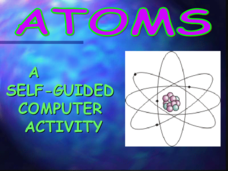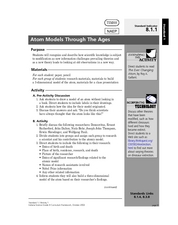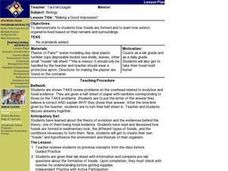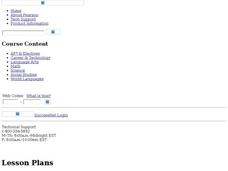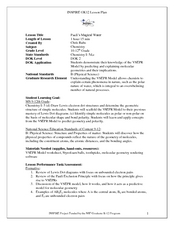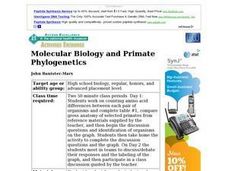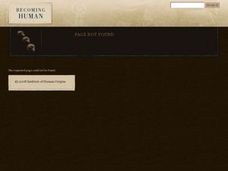Curated OER
Energy Sources and Use
Students read and understand the importance of energy sources. In this Renewable and nonrenewable lesson, students read an article to become familiar with the uses of energy. Students read an article and answer questions...
Curated OER
Art and Anatomy: The Vitruvian Teen
Twelfth graders create an artistic version of a Vetruvian teen. In this anatomy lesson, 12th graders design an experiment to test the theory of the ideally proportioned man. They present their findings in class.
Curated OER
Atoms : A Self Guided Computer Activity
"Self-guided Computer Activity" simply means that young chemists read through the slides and take notes about atoms along the way. There is an abundance of text on each slide, making this a comprehensive introduction to atomic structure....
Curated OER
Evidence of Evolution by Natural Selection - Testable Hypotheses
The factors that affect selection and evolution are investigated here. Information about some common ancestry examples are given but with no real scientific evidence. This presentation is very obvious in making biased claims about...
Curated OER
Family and Social Policy
Delve into the realm of family and social policy using this resource. Learners answer nine questions about social policy, the government's role, and theories.
Curated OER
AP: Chapter 26: Origin of Life
Five pages take biologists on a generalized survey of the origin of life. Queries are made regarding theories of how life developed, ancient Earth conditions, and the ever-changing field of taxonomy. The experiments of different...
Curated OER
Solids
In this solids worksheet, students review terms associated with solid matter including, freezing and melting point, viscosity, and Brownian motion. This worksheet has 1 short answer and 14 matching questions.
Curated OER
Atom Models Through the Ages
Eighth graders explain the development of the atomic model over time. In this chemistry lesson, 8th graders research about the scientists who made a contribution to the atomic theory. They create a three-dimensional model based on their...
Curated OER
Acid and Base Worksheet
In this acids and bases learning exercise, learners apply the Bronsted-Lowry theory of acids and bases to write the products for the given acid-base reactions. This learning exercise has 7 problems to solve.
Curated OER
"Making a Good Impression"
Students are shown how fossils are formed and to learn how extinct organisms lived based on their remains and surroundings. They are shown TAKS review problems on the overhead related to evolution and fossil evidence. Students discuss...
Curated OER
Evolution, Genes, and Behavior
Students examine the roles of genes and evolution on behaviors. In groups, they identify the relationships among DNA, genes and chromosomes. They evaluate the different theories of language acquistion and how evolved tendencies interact...
Curated OER
Evolution
Pupils create a timeline on the history of evolution. In this biology lesson, students research their assigned scientist's contribution to evolution theory. They write a three-paragraph analysis about the timeline.
Curated OER
Walking Whales
Eighth graders explore the theory of evolution of whales. For this walking whales lesson students study a reading packet, divide into groups and respond to given questions.
Curated OER
Why Don't Whales Have Legs?
Students are given a variety of materials and are asked to design a heat loss experiment that results in a reasonable explanation of "Why don't whales have legs?" students work with the theory of natural selection.
Curated OER
Evolution Explorations
Students compare characteristics of animals and human beings. In this biology instructional activity, students observe an animal and record their observations. They infer whether the evolution theory is true or not.
Curated OER
Pauli's Magical Water
Students predict the shape of molecules using VSEPR theory. In this chemistry lesson, students differentiate a polar and nonpolar molecule. They discuss why water's polarity is very important.
Curated OER
Bermuda: Search for Deep Water Caves 2009: Out of Darkness
Students analyze the three models on the origin of troglobitic fauna. In this life science lesson, students also consider how the Zonation model explains the fauna's origin. They also use the Internet to research solutional and volcanic...
Curated OER
The Great Animal Systems Challenge!
Advanced placement biology aces list systems that have evolved over time, adaptations, and structure-function relationships. The resource requires plenty of writing to answer these questions, so allow a few days for them to complete the...
Curated OER
Acids and Bases
In this acids and bases worksheet, learners review the characteristics of acids and bases, pK values, factors that change the rate of reactions, and catalysts. This worksheet has 17 multiple choice questions.
Curated OER
Molecular Biology and Primate Phylogenics
By counting differences in amino acids, biology stars examine the relationships between different primates. With information gleaned, they map out a phylogenic tree and discover common ancestry. You will need to create printable versions...
Curated OER
Learning from Light: The Big Bang
High schoolers explore what astronomers are able to examine our galaxy and universe by examining light. They explore in this sub-unit the formation of the universe, commonly called "The Big Bang," and it follows studying from the Light:...
Curated OER
Adaptations and Evolutions of Species
Examples of natural selection over time will make the concept of evolution more clear to your students. This presentation is short but summarizes the mechanisms of isolation and selection clearly. This presentation would be useful...
Curated OER
Building Bodies
Learners identify key anatomical similarities and differences between great apes and humans. They infer likely anatomical features in ancient human ancestors and list principal anatomical changes in primates necessary for adaptation to...
Curated OER
The "Science" of Racism
How can we keep racism out of our society? Analyze the factors that lead to racism today and research previous scientific findings that impacted social policy. Your high school high schoolers identify ways to prevent past mistakes from...


